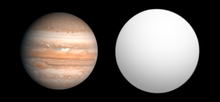astro.wikisort.org - Meteorite
XO-5b "Makropulos" is an extrasolar planet approximately 910 light years away in the constellation of Lynx. This planet was found by the transit method using the XO Telescope and announced in May 2008. It was also independently discovered by the HATNet Project. The planet has a mass and radius just slightly larger than that of Jupiter. This planet orbits very close to the G-type parent star, as it is typical for transiting planets, classing this as Hot Jupiter. It takes only 4.188 days (or 100.5 hours) to orbit at an orbital distance of 0.0488 AU).[1][2]
 Size comparison of Jupiter (left) with XO-5b (right). | |
| Discovery | |
|---|---|
| Discovered by | XO Project[1] |
| Discovery site | XO Telescope at Maui, Hawaii[1] |
| Discovery date | 2008 |
Detection method | Transit[1] |
| Orbital characteristics | |
Semi-major axis | 0.0488 ± 0.0006 AU (7,300,000 ± 90,000 km)[2] |
| Eccentricity | 0[note 1] |
Orbital period (sidereal) | 4.1877545 ± 0.0000016[3] d |
| Inclination | 86.7 ± 0.4[2] |
| Semi-amplitude | 144.9 ± 2.0[2] |
| Star | XO-5 |
| Physical characteristics | |
Mean radius | 1.109 ± 0.050[2] RJ |
| Mass | 1.059 ± 0.028[2] MJ |
Mean density | 0.96+0.14 −0.11[2] g cm−3 |
Surface gravity | 22 ± 5 m/s2 (72 ± 16 ft/s2)[1] |
| Temperature | 1221 ± 27[2] |
The planet XO-5b is named Makropulos. The name was selected in the NameExoWorlds campaign by the Czech Republic, during the 100th anniversary of the IAU. Makropulos is the name from Karel Čapek's play Věc Makropulos (The Makropulos Affair).[4][5]
Discovery
XO-5b was the fifth hot Jupiter transiting planet discovered by the XO Project and was identified as a possible candidate extrasolar planet from two seasons of observations, November 2003 to March 2004 and November 2004 to March 2005. Follow-up photometry was provided by the extended team, a collaboration of professional and amateur astronomers. The team obtained better quality light curves to guide the photometric and spectroscopic follow-up necessary to classify a candidate as an actual planetary companion.[1]
To confirm XO-5b's planetary nature radial velocity observations of XO-5 were made with the high resolution spectrograph on the 11 meter Hobby–Eberly Telescope located at McDonald Observatory, in order to measure the mass of the planet. Commencing on December 7, 2007 a total of ten radial velocity measurements were made which confirmed XO-5b's status as a planet.[1]
Notes
- eccentricity is insignificant compared to its uncertainties[note 2]
References
- Burke, Christopher J.; et al. (2008). "XO-5b: A Transiting Jupiter-sized Planet with a 4 day Period". The Astrophysical Journal. 686 (2): 1331–1340. arXiv:0805.2399. Bibcode:2008ApJ...686.1331B. doi:10.1086/591497.
- Pál, A.; et al. (2009). "Independent Confirmation and Refined Parameters of the Hot Jupiter XO-5b". The Astrophysical Journal. 700 (1): 783–790. arXiv:0810.0260. Bibcode:2009ApJ...700..783P. doi:10.1088/0004-637X/700/1/783.
- Sada, Pedro V.; et al. (2012). "Extrasolar Planet Transits Observed at Kitt Peak National Observatory". Publications of the Astronomical Society of the Pacific. 124 (913): 212–229. arXiv:1202.2799. Bibcode:2012PASP..124..212S. doi:10.1086/665043.
- "Approved names". NameExoworlds. Retrieved 2020-01-02.
- "International Astronomical Union | IAU". www.iau.org. Retrieved 2020-01-02.
External links
![]() Media related to XO-5b at Wikimedia Commons
Media related to XO-5b at Wikimedia Commons
- "XO-5". Exoplanets. Retrieved 2008-08-06.
На других языках
- [en] XO-5b
[es] XO-5b
XO-5b es un planeta extrasolar que se encuentra a aproximadamente 831 años luz en la constelación de Lince. Fue descubierto usando el método de tránsito por McCullough el 19 de mayo de 2008. El planeta tiene una masa de 1,15 MJ y un radio de 1,15 RJ. Este planeta orbita muy próximo a su estrella de Tipo G, como es típico en los planetas en tránsito, quedando clasíficado como un Júpiter caliente.[ru] XO-5 b
XO-5 b — экзопланета на расстоянии 831 светового года от Земли, в созвездии Рыси. Планета была найдена транзитным методом в мае 2008 года. Имеет массу 1,15 MJ и радиус 1,15 RJ, что делает плотность планеты идентичной плотности воды (1000 кг/м³). Планета относится к классу горячих юпитеров.[1]Другой контент может иметь иную лицензию. Перед использованием материалов сайта WikiSort.org внимательно изучите правила лицензирования конкретных элементов наполнения сайта.
WikiSort.org - проект по пересортировке и дополнению контента Википедии